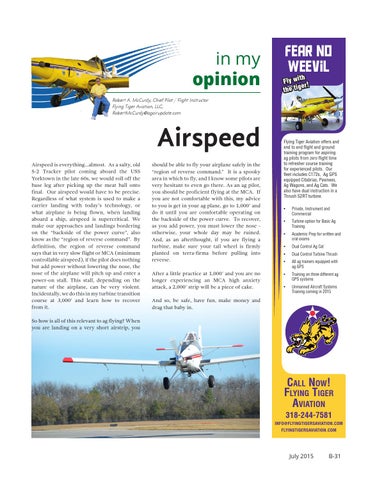in my opinion
Fear No Weevil
th Fly wi ! er the tig
Robert A. McCurdy, Chief Pilot / Flight Instructor Flying Tiger Aviation, LLC, RobertMcCurdy@agairupdate.com
Airspeed Airspeed is everything…almost. As a salty, old S-2 Tracker pilot coming aboard the USS Yorktown in the late 60s, we would roll off the base leg after picking up the meat ball onto final. Our airspeed would have to be precise. Regardless of what system is used to make a carrier landing with today’s technology, or what airplane is being flown, when landing aboard a ship, airspeed is supercritical. We make our approaches and landings bordering on the “backside of the power curve”, also know as the “region of reverse command”. By definition, the region of reverse command says that in very slow flight or MCA (minimum controllable airspeed), if the pilot does nothing but add power without lowering the nose, the nose of the airplane will pitch up and enter a power-on stall. This stall, depending on the nature of the airplane, can be very violent. Incidentally, we do this in my turbine transition course at 3,000’ and learn how to recover from it.
should be able to fly your airplane safely in the “region of reverse command.” It is a spooky area in which to fly, and I know some pilots are very hesitant to even go there. As an ag pilot, you should be proficient flying at the MCA. If you are not comfortable with this, my advice to you is get in your ag plane, go to 1,000’ and do it until you are comfortable operating on the backside of the power curve. To recover, as you add power, you must lower the nose otherwise, your whole day may be ruined. And, as an afterthought, if you are flying a turbine, make sure your tail wheel is firmly planted on terra-firma before pulling into reverse. After a little practice at 1,000’ and you are no longer experiencing an MCA high anxiety attack, a 2,000’ strip will be a piece of cake.
Flying Tiger Aviation offers and end to end flight and ground training program for aspiring ag pilots from zero flight time to refresher course training for experienced pilots. Our fleet includes C172s, Ag GPS equipped Citabrias, Pawnees, Ag Wagons, and Ag Cats. We also have dual instruction in a Thrush S2RT turbine. •
Private, Instrument and Commercial
•
Turbine option for Basic Ag Training
•
Academic Prep for written and oral exams
•
Dual Control Ag Cat
•
Dual Control Turbine Thrush
•
All ag trainers equipped with ag GPS
•
Training on three different ag GPS systems
•
Unmanned Aircraft Systems Training coming in 2015
And so, be safe, have fun, make money and drag that baby in.
So how is all of this relevant to ag flying? When you are landing on a very short airstrip, you
Call now! Call Now! FlyiNg Tiger aviaTioN 318-244-7581 INFO@FLYINGTIGERSAVIATION.COM FLYINGTIGERSAVIATION.COM
July 2015
B-31
